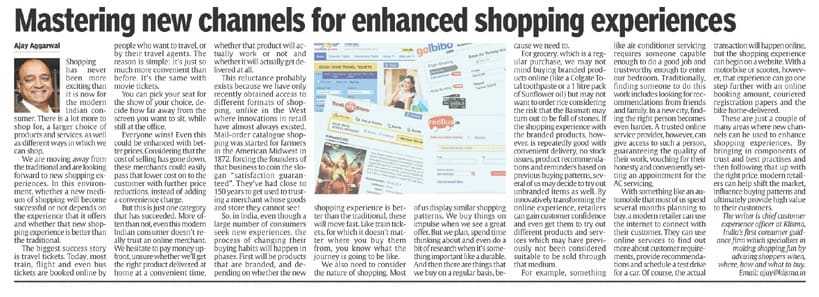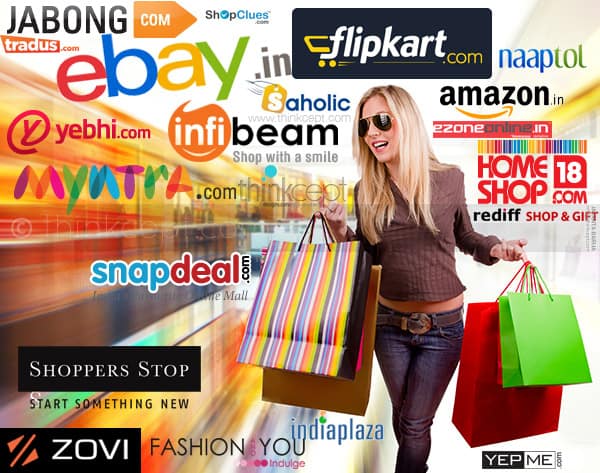Shopping has never been more exciting than it is now for the modern Indian consumer. There is a lot more to shop for, a larger choice of products and services, as well as different ways in which we can shop.
We are moving away from the traditional and are looking forward to new shopping experiences. In this environment, whether a new medium of shopping will become successful or not depends on the experience that it offers and whether that new shopping experience is better than the traditional.

The biggest success story is travel tickets. Today, most train, flight and even bus tickets are booked online by people who want to travel, or by their travel agents. The reason is simple: it’s just so much more convenient than before. It’s the same with movie tickets.
You can pick your seat for the show of your choice, decide how far away from the screen you want to sit, while still at the office.
Everyone wins! Even this could be enhanced with better prices. Considering that the cost of selling has gone down, these merchants could easily pass that lower cost on to the customer with further price reductions, instead of adding a convenience charge.
But this is just one category that has succeeded. More often than not, even this modern Indian consumer doesn’t really trust an online merchant. We hesitate to pay money upfront, unsure whether we’ll get the right product delivered at home at a convenient time, whether that product will actually work or not and whether it will actually get delivered at all.
This reluctance probably exists because we have only recently obtained access to different formats of shopping, unlike in the West where innovations in retail have almost always existed. Mail-order catalogue shopping was started for farmers in the American Midwest in 1872, forcing the founders of that business to coin the slogan “satisfaction guaranteed”. They’ve had close to 150 years to get used to trusting a merchant whose goods and store they cannot see!
So, in India, even though a large number of consumers seek new experiences, the process of changing their buying habits will happen in phases. First will be products that are branded, and depending on whether the new shopping experience is better than the traditional, these will move fast. Like train tickets, for which it doesn’t matter where you buy them from, you know what the journey is going to be like.
We also need to consider the nature of shopping. Most of us display similar shopping patterns. We buy things on impulse when we see a great offer. But we plan, spend time thinking about and even do a bit of research when it’s something important like a durable. And then there are things that we buy on a regular basis, because we need to.
For grocery, which is a regular purchase, we may not mind buying branded products online (like a Colgate Total toothpaste or a 1 litre pack of Sunflower oil) but may not want to order rice considering the risk that the Basmati may turn out to be full of stones. If the shopping experience with the branded products, however, is repeatedly good with convenient delivery, no stock issues, product recommendations and reminders based on previous buying patterns, several of us may decide to try out unbranded items as well. By innovatively transforming the online experience, retailers can gain customer confidence and even get them to try out different products and services which may have previously not been considered suitable to be sold through that medium.
For example, something like air-conditioner servicing requires someone capable enough to do a good job and trustworthy enough to enter our bedroom. Traditionally, finding someone to do this work includes looking for recommendations from friends and family. In a new city, finding the right person becomes even harder. A trusted online service provider, however, can give access to such a person, guaranteeing the quality of their work, vouching for their honesty and conveniently setting an appointment for the AC servicing.
With something like an automobile that most of us spend several months planning to buy, a modern retailer can use the internet to connect with their customer. They can use online services to find out more about customer requirements, provide recommendations and schedule a test drive for a car. Of course, the actual transaction will happen online, but the shopping experience can begin on a website. With a motorbike or scooter, however, that experience can go one step further with an online booking amount, couriered registration papers and the bike home-delivered.
These are just a couple of many areas where new channels can be used to enhance shopping experiences. By bringing in components of trust and best practises and then following that up with the right price, modern retailers can help shift the market, influence buying patterns and ultimately provide high value to their customers.
From a series of articles commissioned by DNA (Money) dated 21 March 2012.

You must be logged in to post a comment.